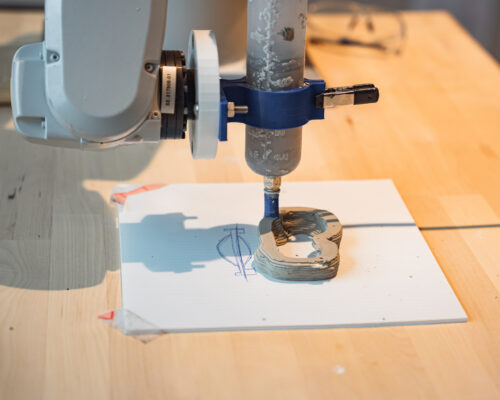Creative Spaces
Robotics Lab
The Spitzer School Robotics Lab has two ABB IRB 120 small but powerful, scalable, industrial-grade six-axis robotic arms, as well as a third, larger arm, an ABB IRB 15000. Two very large arms are also planned for, pending infrastructure development. Students in robotics-focused courses, including special edesign studios, use the lab to critically explore robotics and examine their potential to transform, and perhaps disrupt, modes of present and future design practice.
At Spitzer, robotics is viewed as a design tool, not just a conventional fabrication device. Robots are approached as broadly applicable general-purpose motion devices. The number, scope, and elaboration of functions, processes, and tasks each arm can carry out are nearly endless. One determinant of this flexibility, and a source of great potential, is the physical interface a robotic arm presents to the world — the tools or effectors that, when attached to the end of the arm, allow work to be carried out. The movable end of the arm — the “wrist” — is “open” and flexible and to which can be attached an unlimited number and variety of tools, objects, and small systems. Possibilities include all manner of drawing instruments, scribing tools, light sources, image capture devices, grippers, virtually any hand or power tool, extruders, grinders, and milling equipment. Harnessing robots’ precise programmed motion control, connection to robotic arms of cameras, video screens, and other visual production devices opens an entire realm of possibilities for architectural conceptualization, representation, documentation, expression, and even entertainment.
The lab utilizes several software tools including HAL, Robots GH plug-in, and Mimic. These interface with familiar design applications such as Rhino, Grasshopper, and Maya, providing a bridge to Robot Studio, an industrial-grade comprehensive robot control and simulation suite. The lab also has available advanced 3-D printers and a host of tools to serve students and faculty working in the Spitzer Robotics Lab.










